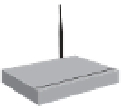Information Technology Reference
In-Depth Information
The Apple Remote is a remote control device made for use with Apple infrared products.
It has six buttons: Menu, Play/Pause, Volume Up, Volume Down, Previous/Rewind, and
Next/Fast-Forward. The new Mac Mini features an infrared port designed to work with the
Apple Remote and support Front Row, a multimedia application that allows users to access
shared iTunes and iPhoto libraries and video throughout their homes.
Zigbee
Zigbee is a form of wireless communications frequently used in security systems and heating
and cooling control systems. Zigbee is a relatively low-cost technology and requires little
power, which allows longer life with smaller batteries.
Energy Optimizers, Ltd, a company in the United Kingdom, has developed a plug-in
electricity meter called the Plogg that can monitor the energy usage of appliances. The device
uses the Zigbee protocol to collect data from refrigerators, air conditioners, and other appli-
ances and relay it to a central server via the Internet. Should an appliance be left on after
hours, the Plogg can alert someone or turn the device down or off.
15
Medium Range Wireless Options
Wi-Fi is a wireless telecommunications technology brand owned by the Wi-Fi Alliance,
which consists of about 300 technology companies including AT&T, Dell, Microsoft, Nokia,
and Qualcomm. The alliance exists to improve the interoperability of wireless local area
network products based on the IEEE 802.11 series of telecommunications standards.
With a Wi-Fi wireless network, the user's computer, smartphone, or personal digital
assistant has a wireless adapter that translates data into a radio signal and transmits it using
an antenna. A wireless access point, which consists of a transmitter with an antenna, receives
the signal and decodes it. The access point then sends the information to the Internet over
a wired connection (see Figure 6.3). When receiving data, the wireless access point takes the
information from the Internet, translates it into a radio signal, and sends it to the device's
wireless adapter. These devices typically come with built-in wireless transmitters and software
to enable them to alert the user to the existence of a Wi-Fi network. The area covered by one
or more interconnected wireless access points is called a “hot spot.” Current Wi-Fi access
points have a maximum range of about 300 feet outdoors and 100 feet within a dry-walled
building. Wi-Fi has proven so popular that hot spots are popping up in places such as airports,
coffee shops, college campuses, libraries, and restaurants.
Wireless network
Figure 6.3
Wi-Fi Network
Existing wired network
Data transmitted and received
through airwaves
Internet
Wireless access point
Cable modem/router











































































































































































































































